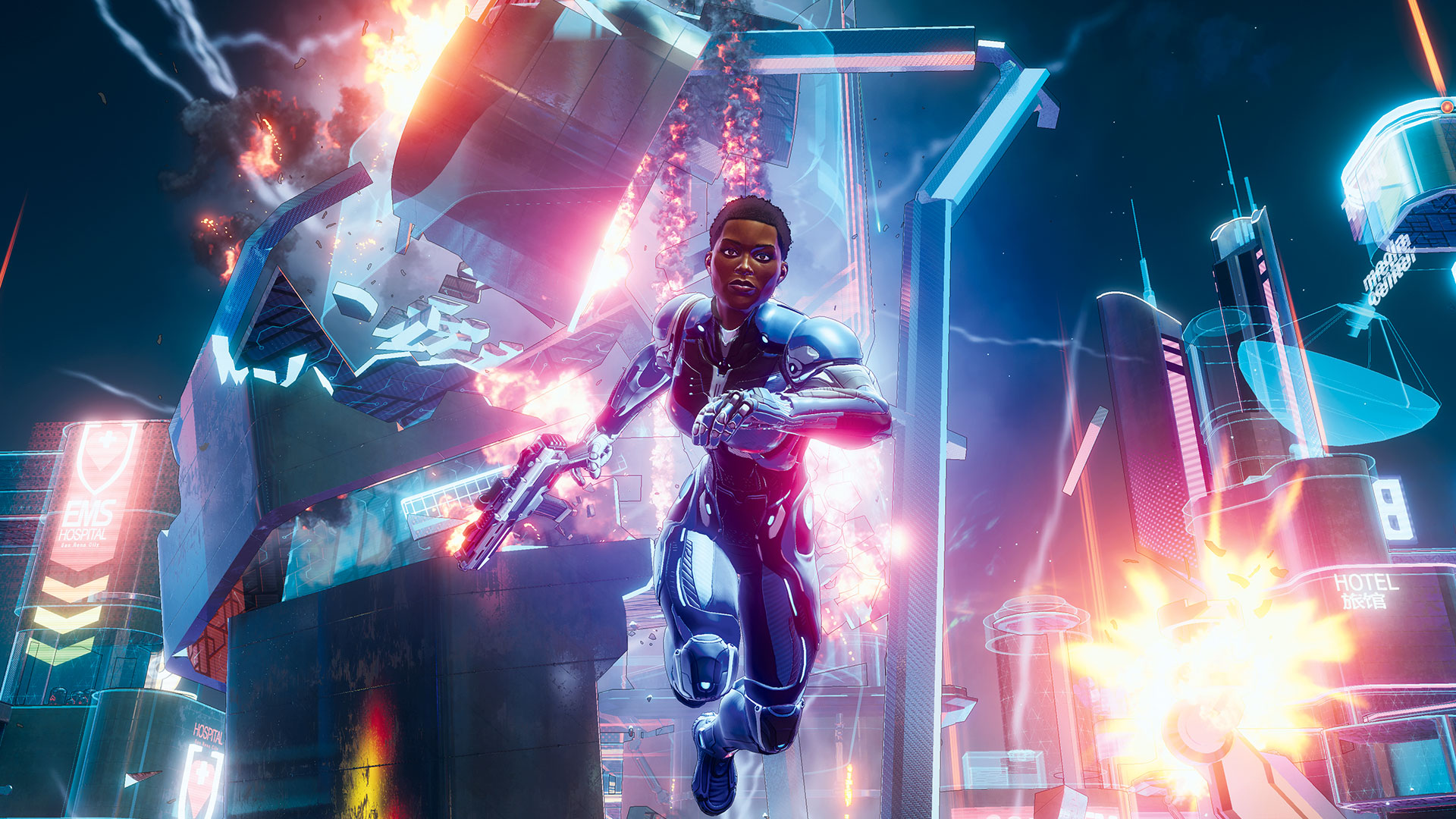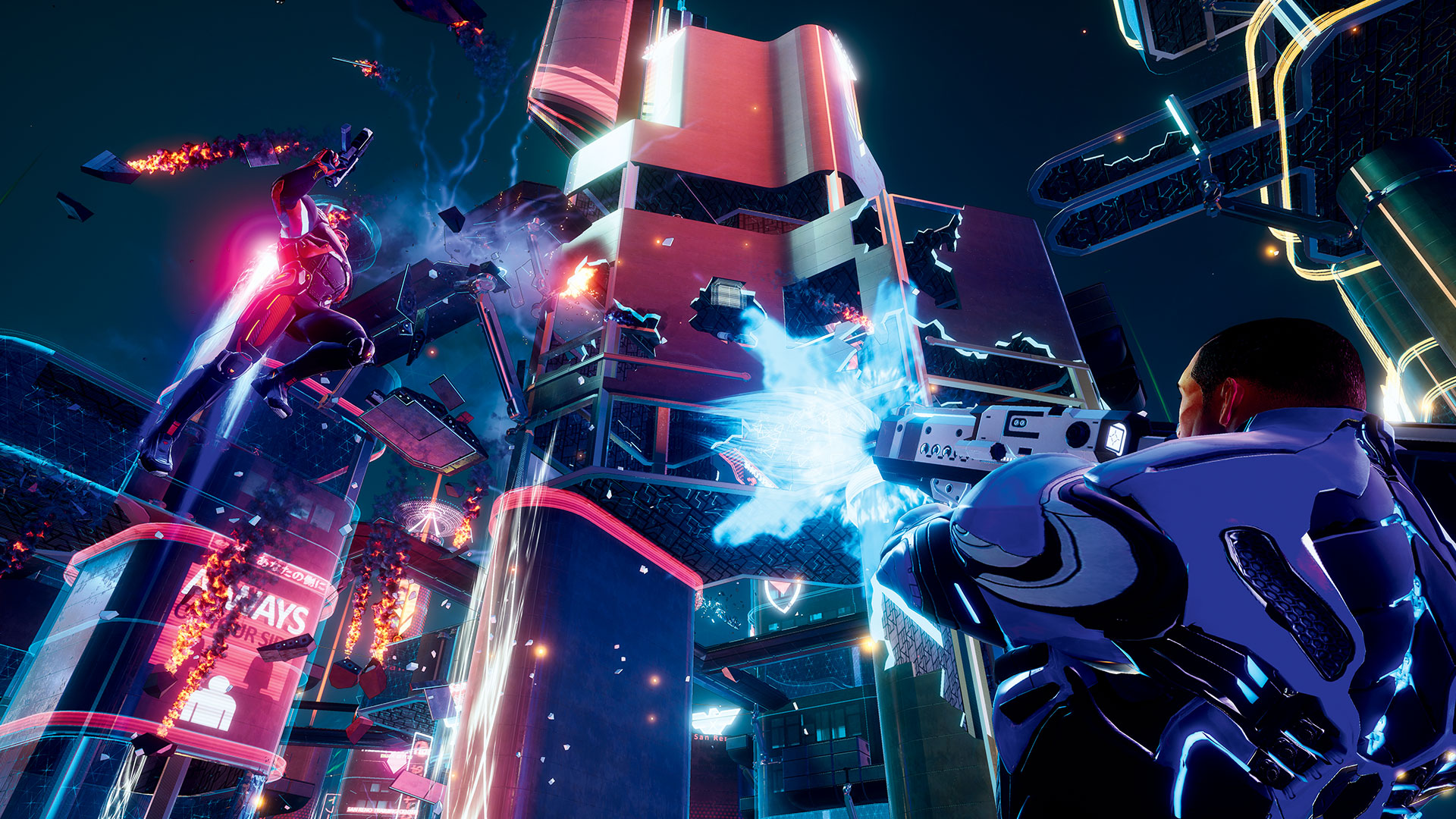
There’s a very real delight to be had in pulling a building down around a group of otherwise aggressive enemies in the Crackdown 3 Wrecking Zone multiplayer mode. Perched atop a towering skyscraper, it’s difficult not to get drawn into the sheer, incredible spectacle of it all; mouth agape, eyes blinded by the collapsing neon fixtures of the futuristic cityscape enveloping you.
The Agents begin to desperately scramble for cover through falling debris, crashing through walls and windows as they tumble to the ground with weapons drawn high, all in an effort to outmanoeuvre encroaching players before the bullets start flying.
- Here are the latest Crackdown 3 singleplayer details straight from the developer
- In a new interview on Crackdown 3's mutiplayer Microsoft admits it "didn't know if we could make it fun"
The firefight ends almost as quickly as it started, with twinkling dog tags soon littering the ground where entire structures once stood tall. There’s just seconds to collect them before the next entanglement begins, before the Agents return to the simulation to seek revenge. It's an incredible take on high-octane multiplayer action where victory is never guaranteed, nor is the shape of the city after a few frantic minutes of combat – the landscape a smouldering wreckage of bullet-ridden buildings and fractured intentions. It’s pretty radical, in every sense of the word.
Bringing down the house
It is, however, worth taking a second to reflect on Crackdown 3’s very public crawl through development hell, because getting the game into a position where it can be primed and ready for release on 15 February 2019 is an achievement in and of itself for Microsoft Game Studios. After four years of development, driven by no less than four different studios, and after four delays have kept it perpetually out of reach, the game is thankfully finally ready to take the world by storm.
It means that, in just a few short months, you’ll be able to see what Microsoft’s Azure cloud network is truly capable of. You’ll be able to experience how it will power the next generation of game experiences; how it will work to set a new benchmark for fidelity and emergent chaos in multiplayer sessions.

We won’t bore you with the specifics as it is all extremely complicated, a technical accomplishment that Microsoft Game Studios admits it has only gotten working as intended in the last 12 months or so, but you should trust us when we tell you that it is pretty goddamned spectacular. By using its established cloud infrastructure – a bank of data-centres made up, effectively, of interlaced Xbox One units – Microsoft’s engineering team has been able to offload all of the advanced physics calculations necessary to power something as revolutionary as Crackdown 3’s awe-inspiring destruction. And it can do it without taking anything at all away from the game’s gorgeous graphics, silky smooth framerate or its heart- pounding moment-to-moment action – if anything it enhances it entirely.
That’s because Ruffian Games – the team responsible for both Crackdown 2 and the multiplayer side to Crackdown 3 – effectively has up to 12 times the processing power of the Xbox One X (or 30 times the original base Xbox One) to play with. The hard work is handled behind-the-scenes, up there in the cloud, so all you need to worry about is tracking Agents through the chaos and keeping your mind focused on the objective at hand as the world crumbles down around you.
Weekly digests, tales from the communities you love, and more

Crackdown 3 isn’t the first game to utilise this cloud-based technology, but it is unquestionably the most impressive application of it to date. Thus far, we’ve seen it used to power the machine-learning artificial intelligence in Forza Horizon 4 and Forza Motorsport 7’s multiplayer, as well the AI mobs in Titanfall 2’s Attrition and Halo 5’s Warzone multiplayer (not to mention these games’ dedicated servers). This is, however, the first time we’ve seen Azure used to calculate something as complex as game physics across a shared- experience in real-time. And believe us, the results really are something to behold.
What it means is that, regardless of the strength of your internet connection, you’ll be able to jump into Wrecking Zone and bask in the glory that is 100 per cent destruction without any noticeable impact to the core game experience. You’ll be able to stand alongside nine other players and literally tear an entire city apart piece by piece, grappling with your foes as you shred through environments with wild abandon. By utilising the Azure network, Crackdown 3 is able to render hundreds upon hundreds of individual pieces of debris in real- time, for every one of the players in any given game.
A head in the clouds
In effect it means that, were we to be running away from a gaggle of enemies, we could use an assault rifle to hastily carve a makeshift door into the façade of an approaching building in an effort to break line-of- sight, and that will synchronise for every player in the game without any delay. Perhaps you may see an enemy running along a bridge overhead – rather than leaping up to their level in an effort to engage them, you could whip out a rocket launcher and rip the floor right out from under their feet, catching them unawares and open to an easy kill. As you may imagine, this makes for some fairly interesting, if not totally awesome, gameplay scenarios and opportunities that – to put it simply – no other multiplayer game on the market can accurately capture or reproduce.
While the single-player component of Crackdown 3 might be focused wholeheartedly around the acquisition of power, the multiplayer puts its focus on extreme manoeuvrability. Given that you could be under siege from any direction, at any point in time, it should come as no surprise that this is a game mode based around awareness and movement.

The gunplay is a strictly lock-on affair, with a squeeze of the Left Trigger focusing the attention of your reticule onto an enemy in direct line-of-sight. The skill in Wrecking Zone isn’t in mastering the mechanics of the weapons, but mastering your traversal of the environment – understanding how to quickly break line-of-sight and gain a height advantage on a would-be aggressor is everything.
Speed is king. Your Agent – one of 21 different character models you can cycle between ahead of jumping into the fray – will need to utilise an array of double jumps and aerial dashes to properly manoeuvre across the cityscape, manipulating the terrain and navigating through falling debris with jet-propelled punches as you do. Wrecking Zone is inherently aggressive in its design; each of the weapons provided in our play session were big and bulky, as excellent at ripping through enemies as they are ripping through steel.
Speed demon
Health regenerates if you can avoid being shot at for five seconds, while colour coded lines denote whether you are being actively targeted or have been successful in breaking line-of-sight. It’s a fairly simple but mostly very effective system, one that’s designed to ensure that you’re never overwhelmed in what should be a stressful scenario for a multiplayer match. The game’s mechanically-light design works to give you the freedom of mind to focus on the environment, to be drawn towards explosions and always on the hunt for your next spectacular kill..
Agent Hunter – Crackdown 3’s variation on Kill Confirmed – is being pitched as the premiere game mode, pitching five Agents versus another five in a desperate battle to slay enemy players and grab their dog tags to score a point. Our favourite of the modes presented during our hands-on session, however, was Territories, which sees teams battle it out for control over ever-shifting territory spaces across a landscape that is forever changing as the battle rages on. As skyscrapers fall, as cover becomes obliterated, and as the composition of the environment warps to the flow of combat, the tension in play is only heightened over time.

Of the two maps and two game modes that we experienced in our time with Wrecking Zone, it was undeniably exhilarating – but it was also unquestionably content-light. Microsoft wasn’t quite ready to give us any insight into the progression systems running behind the action, but we do still have concerns over the longevity of it all. As impressive as the physics-based destruction is – the core underlying technology powering it all – the mechanics and systems layered on top of it are easily mastered. It wasn’t long before we were taking the fight to the developers and testers who were responsible for building and streamlining the damned thing.
That said, so much of the fun to be had in the core experience comes from the emergent moments that come up naturally during play. Wrecking Zone is one of those modes that will truly spring to life as teams of players begin to experiment, as they push against the limits of Crackdown 3’s design and destruction. It’s a sandbox purpose-built to let players run wild and experiment; it’s exhilarating to successfully pull off a manoeuvre that involves toppling a building leaving enemies open, pulling scrambling foes into chokepoints as their cover is obliterated by heavy focused fire. We get the feeling that the more time players spend experimenting with Wrecking Zone, its maps and its destruction, the more intoxicating it will become.
Cracking time
Microsoft’s commitment to Crackdown has never once wavered. The game has outlasted Fable Legends, Phantom Dust and Scalebound; it is still being positioned as a franchise that can stand shoulder-to-shoulder with the likes of Halo, Forza and Gears 5. The reason for that, we believe, is because of Wrecking Zone – it establishes Crackdown as a series that can showcase the true power of the Xbox platform.
Wrecking Zone is only possible in its current form because of Azure, because of the cloud infrastructure Microsoft has established. It really is incredible technology and what’s difficult to believe is that this is only the beginning. Crackdown 3 is going to be the best example of what this tech can do in the hands of ambitious development teams.
This originally appeared in the January issue of Official Xbox Magazine. Want more content like this, sign yourself up for a subscription below:
Official Xbox Magazine subscriptions Get yourself 13 glorious issues of OXM right now from just £4.61 per issue at MyFavouriteMagazines.

Josh West is the Editor-in-Chief of GamesRadar+. He has over 15 years experience in online and print journalism, and holds a BA (Hons) in Journalism and Feature Writing. Prior to starting his current position, Josh has served as GR+'s Features Editor and Deputy Editor of games™ magazine, and has freelanced for numerous publications including 3D Artist, Edge magazine, iCreate, Metal Hammer, Play, Retro Gamer, and SFX. Additionally, he has appeared on the BBC and ITV to provide expert comment, written for Scholastic books, edited a book for Hachette, and worked as the Assistant Producer of the Future Games Show. In his spare time, Josh likes to play bass guitar and video games. Years ago, he was in a few movies and TV shows that you've definitely seen but will never be able to spot him in.



